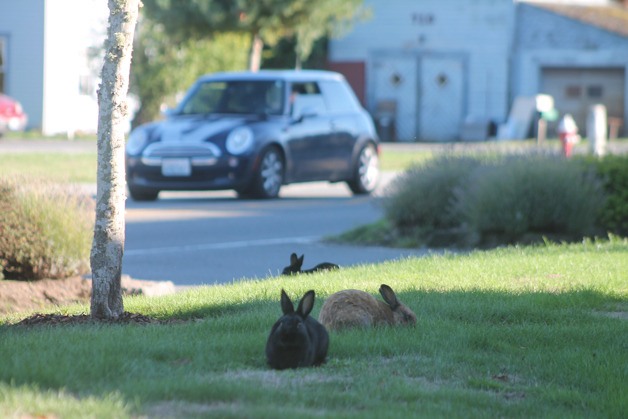Finding a way to address the concerns of property owners in Langley has remained as challenging as trying to catch the rascally rabbits at the heart of the citywide issue.
An informal group of agencies and residents gathered for another strategy session Tuesday at Langley City Hall. Some of the ideas floated as possible solutions were: a trap-and-relocate program; the previously reported use of muzzled ferrets to ferret out the rabbits from underground tunnel systems called warrens at the middle school campus and fairgrounds; and releasing or distributing city-sponsored information about ways to repel rabbits and keep them from nesting and breeding.
“This could be solved in such a way that everybody wins,” said Mel Watson, a Langley-area resident who has championed non-lethal solutions and described herself as being a voice for the bunnies. She represented the Langley Rabbit Society, an informal group of people committed to finding nonlethal, non-cruel means of addressing the rabbit population problem.
Rabbit overpopulation grew to such proportions this year that residents regularly requested Langley City Hall take action. Mayor Fred McCarthy stepped in where previous administrations had elected to ignore the complaints by residents that the rabbits were damaging gardens, yards and landscaping. But his interest stopped well short of calling for a Langley-wide Orycolagus cuniculus (common rabbit) culling in the vein of Elmer Fudd or the fabled St. Patrick.
Meeting with other representative stakeholders and a couple of residents Tuesday, the eight members of the Langley rabbit committee focused on providing ample information about how to repel rabbits rather than any lethal solutions.
“I believe there’s a way,” Watson said.
At the other end of the debate are Langley residents like Sylvia Hollis. She described the impact to her home as having sustained “terrible damage” from rabbits rooting up her yard to defecating across her property, making it nearly impassable without caking her shoes in feces.
“They’re the first thing I see in the morning and the last thing I see at night,” she said.
Her problems were not unique.
Mayor-elect Tim Callison, who later offered to chair the committee once McCarthy leaves office at the end of the year, said his home has similarly suffered destruction from voracious rabbits.
“The damage to my yard is becoming more severe and more frequent,” Callison said, showing the members a photo of his front yard with a few dug up holes.
Opinions at the opposite ends of the discussion represent the very nature of the fight. Langley City Hall is in the middle of a battle over animal rights and property rights; of having a conscience to do no undue harm to the small, floppy eared critters commonly kept as pets, and having an obligation to address public nuisances, despite their resemblance to a stuffed animal.
Not wanting bunny blood on their hands, McCarthy and the city council have leaned toward a do-nothing approach. Langley, as a city entity, will not dedicate funds for a master hunter from the Washington Department of Fish and Wildlife to come in and clear out rabbits for a rough cost of $100 a head.
Instead, Langley and the rabbit committee – consisting of an employee from the South Whidbey School District, Port of South Whidbey/Island County Fairgrounds, and City of Langley – will be an informational resource. By gathering information for a pamphlet or a web page, people can check with the city first. Want to know if you can shoot a bunny in your back yard (the discharge of a firearm in Langley city limits is illegal), call city hall. Wondering what repellents work best, or how much it may cost to have them removed by live traps? Call city hall.
Clearing some of the large, public properties of rabbits may not cost any of the agencies a penny. Clinton-based raptor expert Steve Layman offered to obtain and train at least four ferrets for the purpose of utilizing them in Langley. Layman has addressed small mammal overpopulation problems in other places, the most famous of which was at San Juan Island National Historic Park.
Once the ferrets drive them out of their warrens, the rabbits would either be trapped and relocated, or let loose to wander the wilds. The warren entrances would be filled in, and it’s believed that sooner or later the rabbits would learn to stay away.
“If a warren is disturbed enough, filling in the holes, filling in the holes, filling in the holes, they won’t come back,” Layman said.
One of the options, however unlikely some of the group’s members said it may be, discussed by some of the agency representatives, is the creation of a sanctuary for rabbits somewhere in town. Watson shared a pamphlet about just such a place in Sequim, which she described as a tourist attraction that takes rabbits from as far away as British Columbia, Canada. Putting one in Langley could be another draw, Watson said, just as whale watching has become.



